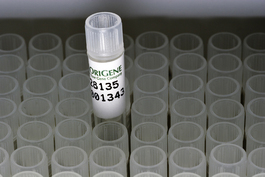CD43 (SPN) (NM_001030288) Human Untagged Clone
CAT#: SC302510
SPN (untagged)-Human sialophorin (SPN), transcript variant 1
"NM_001030288" in other vectors (4)
Product Images

Specifications
| Product Data | |
| Type | Human Untagged Clone |
| Tag | Tag Free |
| Symbol | SPN |
| Synonyms | CD43; GALGP; GPL115; LSN |
| Vector | pCMV6-Entry |
| E. coli Selection | Kanamycin (25 ug/mL) |
| Mammalian Cell Selection | Neomycin |
| Sequence Data |
>NCBI ORF sequence for NM_001030288, the custom clone sequence may differ by one or more nucleotides
ATGGCCACGCTTCTCCTTCTCCTTGGGGTGCTGGTGGTAAGCCCAGACGCTCTGGGGAGCACAACAGCAG TGCAGACACCCACCTCCGGAGAGCCTTTGGTCTCTACTAGCGAGCCCCTGAGCTCAAAGATGTACACCAC TTCAATAACAAGTGACCCTAAGGCCGACAGCACTGGGGACCAGACCTCAGCCCTACCTCCCTCAACTTCC ATCAATGAGGGATCCCCTCTTTGGACTTCCATTGGTGCCAGCACTGGTTCCCCTTTACCTGAGCCAACAA CCTACCAGGAAGTTTCCATCAAGATGTCATCAGTGCCCCAGGAAACCCCTCATGCAACCAGTCATCCTGC TGTTCCCATAACAGCAAACTCTCTAGGATCCCACACCGTGACAGGTGGAACCATAACAACGAACTCTCCA GAAACCTCCAGTAGGACCAGTGGAGCCCCTGTTACCACGGCAGCTAGCTCTCTGGAGACCTCCAGAGGCA CCTCTGGACCCCCTCTTACCATGGCAACTGTCTCTCTGGAGACTTCCAAAGGCACCTCTGGACCCCCTGT TACCATGGCAACTGACTCTCTGGAGACCTCCACTGGGACCACTGGACCCCCTGTTACCATGACAACTGGC TCTCTGGAGCCCTCCAGCGGGGCCAGTGGACCCCAGGTCTCTAGCGTAAAACTATCTACAATGATGTCTC CAACGACCTCCACCAACGCAAGCACTGTGCCCTTCCGGAACCCAGATGAGAACTCACGAGGCATGCTGCC AGTGGCTGTGCTTGTGGCCCTGCTGGCGGTCATAGTCCTCGTGGCTCTGCTCCTGCTGTGGCGCCGGCGG CAGAAGCGGCGGACTGGGGCCCTCGTGCTGAGCAGAGGCGGCAAGCGTAACGGGGTGGTGGACGCCTGGG CTGGGCCAGCCCAGGTCCCTGAGGAGGGGGCCGTGACAGTGACCGTGGGAGGGTCCGGGGGCGACAAGGG CTCTGGGTTCCCCGATGGGGAGGGGTCTAGCCGTCGGCCCACGCTCACCACTTTCTTTGGCAGACGGAAG TCTCGCCAGGGCTCCCTGGCGATGGAGGAGCTGAAGTCTGGGTCAGGCCCCAGCCTCAAAGGGGAGGAGG AGCCACTGGTGGCCAGTGAGGATGGGGCTGTGGACGCCCCAGCTCCTGATGAGCCCGAAGGGGGAGACGG GGCTGCCCCTTAA |
| Restriction Sites | SgfI-MluI |
| ACCN | NM_001030288 |
| OTI Disclaimer | Our molecular clone sequence data has been matched to the reference identifier above as a point of reference. Note that the complete sequence of our molecular clones may differ from the sequence published for this corresponding reference, e.g., by representing an alternative RNA splicing form or single nucleotide polymorphism (SNP). |
| OTI Annotation | This TrueClone is provided through our Custom Cloning Process that includes sub-cloning into OriGene's pCMV6 vector and full sequencing to provide a non-variant match to the expected reference without frameshifts, and is delivered as lyophilized plasmid DNA. |
| Product Components | The cDNA clone is shipped in a 2-D bar-coded Matrix tube as dried plasmid DNA. The package also includes 100 pmols of both the corresponding 5' and 3' vector primers in separate vials. Every lot of primer is tested to provide clean sequencing of OriGene TrueClones. |
| Reconstitution | 1. Centrifuge at 5,000xg for 5min. 2. Carefully open the tube and add 100ul of sterile water to dissolve the DNA. 3. Close the tube and incubate for 10 minutes at room temperature. 4. Briefly vortex the tube and then do a quick spin (less than 5000xg) to concentrate the liquid at the bottom. 5. Store the suspended plasmid at -20°C. The DNA is stable for at least one year from date of shipping when stored at -20°C. |
| Reference Data | |
| RefSeq | NM_001030288.2, NP_001025459.1 |
| RefSeq Size | 6944 bp |
| RefSeq ORF | 1203 bp |
| Locus ID | 6693 |
| Cytogenetics | 16p11.2 |
| Protein Families | Druggable Genome, ES Cell Differentiation/IPS, Transmembrane |
| Protein Pathways | Cell adhesion molecules (CAMs) |
| Gene Summary | 'This gene encodes a highly sialylated glycoprotein that functions in antigen-specific activation of T cells, and is found on the surface of thymocytes, T lymphocytes, monocytes, granulocytes, and some B lymphocytes. It contains a mucin-like extracellular domain, a transmembrane region and a carboxy-terminal intracellular region. The extracellular domain has a high proportion of serine and threonine residues, allowing extensive O-glycosylation, and has one potential N-glycosylation site, while the carboxy-terminal region has potential phosphorylation sites that may mediate transduction of activation signals. Different glycoforms of this protein have been described. In stimulated immune cells, proteolytic cleavage of the extracellular domain occurs in some cell types, releasing a soluble extracellular fragment. Defects in expression of this gene are associated with Wiskott-Aldrich syndrome. [provided by RefSeq, Sep 2017]' Transcript Variant: This variant (1) represents the longer transcript. Variants 1 and 2 encode the same protein. Sequence Note: This RefSeq record was created from transcript and genomic sequence data to make the sequence consistent with the reference genome assembly. The genomic coordinates used for the transcript record were based on transcript alignments. |
Documents
| Product Manuals |
| FAQs |
Resources
Other Versions
| SKU | Description | Size | Price |
|---|---|---|---|
| RC214120 | SPN (Myc-DDK-tagged)-Human sialophorin (SPN), transcript variant 1 |
USD 420.00 |
|
| RG214120 | SPN (GFP-tagged) - Human sialophorin (SPN), transcript variant 1 |
USD 460.00 |
|
| RC214120L3 | Lenti ORF clone of Human sialophorin (SPN), transcript variant 1, Myc-DDK-tagged |
USD 768.00 |
|
| RC214120L4 | Lenti ORF clone of Human sialophorin (SPN), transcript variant 1, mGFP tagged |
USD 620.00 |
{0} Product Review(s)
Be the first one to submit a review






























































































































































































































































 Germany
Germany
 Japan
Japan
 United Kingdom
United Kingdom
 China
China
